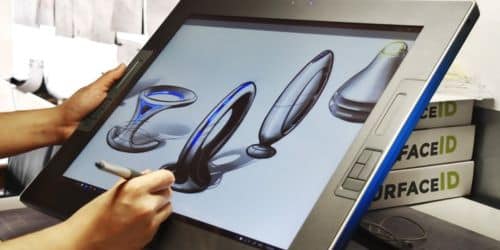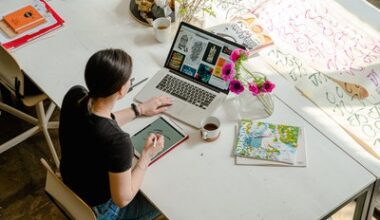As our society becomes increasingly digitized, product design has risen to the top of the design hierarchy, both in the startup world and among established corporations. This is especially true when breaking into a market that directly serves end users. Because of these changes in the industry, any creative person can now pursue a rewarding career as a product designer. However, without an in-depth understanding of the UX design process, defining the function of a product designer is more challenging. Plus, if you want to succeed as a product designer, you’ll need to develop applicable talents and a portfolio. Read on to learn more about the career path of a product designer, including salary, portfolio, company, and how to become one.
What is a Product Designer?
A product designer is someone who is in charge of overseeing the entire design process of a product or the enhancement of an already existing product. Product designers may come up with ideas for addressing present problems, get feedback from key players, and serve as a liaison between designers, engineers, and researchers while also assisting in creating wireframes and prototypes for mock-ups. They are aware of the smaller aspects necessary to accomplish the larger aims of the product while comprehending what they are.
A product designer is in charge of a product’s user experience and generally receives guidance from product management regarding the company’s goals and objectives. Product designers frequently work on the visual and tactile features of a product, but they can also contribute to its information architecture and system design.
Depending on the type of business, the size and diversity of the design department, and the specific person’s area of expertise, a product designer may also be referred to as a User Experience Designer, Customer Experience Architect, User Interface Designer, Interaction Designer, or Information Architect.
What Does a Product Designer Do?
Product designers focus on creating solutions for digital goods and coming up with the best ways to use those goods. While the specific duties of a product designer may change depending on the specific requirements of a given design team or company, it is common practice for product designers to engage in user experience (UX) research to identify common user problems and provide solutions that balance those problems with organizational objectives. Project management and post-launch product development are two common responsibilities for product designers. Designers work with pre-existing goods to improve user experiences and manage the design’s ongoing iteration.
A product designer is useful at any stage of a company, but especially during the research and development phases. They may help transform the product’s vision into a workable user experience and give input on the features that must be in place to help end users accomplish their goals during the prototype and concept phases of development.
As a product evolves and gains new capabilities, designers and developers can refine the interface to make it more user-friendly. Once a product has reached maturity, it can assist with honing the user experience and making it more efficient, thereby accelerating page loads, etc.
Some businesses may not perceive the need to engage a product designer until later in their development, while others may do so before they even have a product manager. As with software development, product design is something that many businesses outsource to consultants and agencies.
Key Responsibilities of a Product Designer:
The responsibilities of a product designer can be summed up in a few broad categories. Among these are:
#1. Designing:
Although a product designer’s responsibilities can vary widely, design remains their primary focus. A product designer will use their expertise in areas such as color theory, typography, and attention to detail to conceptualize, prototype, and finalize a product.
#2. Keeping the User in Mind:
Generally, product designers will incorporate user experience design ideas into their work. This goes beyond simply making the product easy to use. A/B testing, email surveys, and other forms of UX research are all things that product designers should be familiar with, as are the practices of wireframing, prototyping, and journey mapping.
#3. Working Together Across Teams:
A product designer is someone who considers the big picture when designing a product, and as such, they frequently work with other designers, researchers, and business teams. As a result, the final product is more likely to meet the company’s expectations and incorporate all the features and improvements users want.
Is UI/UX the Same as Product Design?
User experience (UX) and user interface (UI) design are both aspects of the broader idea of product design. The entire user experience with a digital product is the emphasis of UX design. A digital product’s visual experience, including its fonts, colors, and animations, is the emphasis of user interface design (UI).
What Qualifications Do I Need to Be a Product Designer?
It’s true that some of the best product designers in the world never attended design school or even studied a course online. That, meanwhile, is not to discount the work of the many other designers who have tackled these problems and found solutions. It’s ultimately up to you and how you take in information.
However, in recent developments, employers are now requiring at least a high school graduation or attainment of a General Equivalency Diploma (GED) in the field of product design due to the broad applicability of the skills and knowledge it comes with. A bachelor’s degree in engineering, marketing, graphic design, or a similar discipline may also be required or preferred by some product design firms.
Regardless, you may need to have or be able to;
- Design abilities and information
- The capacity to devise novel solutions to problems
- Must be meticulous and detail-oriented
- Knowledge of production techniques, materials, and technology
- Analytical abilities in thought
- Perseverance and tenacity
- Reasoning and analytical abilities
- Talents for addressing difficult problems
- To be proficient in using a computer and the most common software programs
How to Become a Product Designer
You can take the following actions to pursue a career as a product designer:
#1. Obtain a High School Diploma
Because a high school certificate or GED gives you the fundamental information and abilities you may apply to almost any industry, employers frequently demand that candidates for product design roles have one. Meanwhile, if you’re still in high school, you can think about enrolling in elective courses like technology, math, art, and graphic design. You can also gain a fundamental understanding of your knowledge and abilities. You can basically acquire these skills as a product designer by taking these classes.
#2. Get A Bachelor’s Degree
Some firms prefer or demand employees with a bachelor’s degree in a similar discipline to the area of product design you’re studying, such as engineering, marketing, graphic design, etc. A bachelor’s degree can help you stand out from other applicants. Even if a company doesn’t demand one for this position, it still doesn’t stop you from getting one. Gaining insight into these subjects can also help you build your designer portfolio and speak comfortably with a hiring manager about product design-related issues.
#3. Hone Your Skills
Many hiring managers want to assess applicants’ skill sets to understand the equipment, software, and programs they are familiar with using. Knowing you have experience in a particular field may persuade them. And as such, they may give you the job before other applicants because you may need less training.
Hence, before you decide to pursue a career in product design, think about gaining knowledge of the various tools used in the field and enhancing your soft skills. This can help you stay organized and get along with people. In addition, it may increase your chances of landing a job by helping you get ready for an interview.
#4. Gain Experience
Having expertise in product design or other similar professions can help you land a job in the field, as it does with many design positions. So, evaluate career prospects in marketing, business, customer service, or a profession that emphasizes communication or problem-solving.
Your ability to better comprehend and satisfy client needs and expectations, solve design issues, put your method into practice, and assist companies in reaching their sales targets may all be made possible by the abilities you acquire from these positions. Consider volunteer work, internships, freelance work, and entry-level employment as options.
#5. Build a Portfolio.
You can demonstrate to potential employers your skills and experience as a product designer by building a portfolio. If you don’t have much experience in the industry, you can incorporate school projects or independent work to demonstrate your abilities.
If you have experience in other facets of product design, you can also include some of those projects in your designer portfolio. However, focus on the types of design projects you want to specialize in for your career. This variation demonstrates to employers your adaptability and breadth of knowledge.
#6. Keep Abreast of Industry Trends
Based on design trends, industry best practices, and cutting-edge technologies, the field of product design is always evolving. Following these developments can help you apply them to your work and respond to inquiries about trends in a job interview.
A hiring manager might inquire so they can be sure you have a stake in the industry and can adjust accordingly. To immerse yourself in pertinent content, think about subscribing to podcasts, blogs, emails, and other forms of media from companies that specialize in product design and industry leaders.
#7. Create a Resume
Product designers are frequently required to provide a résumé along with their application so that employers may assess their qualifications. Make sure your resume showcases your pertinent talents, abilities, and professional experience and that your contact information is up to date. You can also highlight your motivations for applying to a certain company and the distinctive qualities you will bring to the business with the use of a descriptive professional summary.
Product Designer Company
It’s crucial to have competent people on the team while developing a product from the start. Hence, knowing a product design company to work with might be as crucial as the job at hand. While there are numerous companies out there, we compiled a list of the best product design firms to consider investing in 2023.
Without further ado, here is a list of top product design companies you may consider in 2023;
- Aras™ Digital Products
- Beyond
- Design First
- Echo & Co
- Fuzzy Math
- Grio
- Think
- Ustwo
- UPQODE
- UX studio
- Wandr studio
Salary of Product Designer
According to Glassdoor, a Product Designer in the United States earns an estimated $91,560 in total compensation annually, with an average salary of $86,201. These figures show the median, or the midpoint of the ranges, from our unique Total Pay Estimate methodology, which is based on data about wages gathered from Glassdoor users. The average annual increase in salary is predicted to be $5,359. Cash bonuses, commissions, tips, and profit sharing are all possible forms of additional compensation. The values in the “Most Likely Range” fall between the 25th and the 75th percentile of all the pay information that is currently available for this role.
However, your income may vary according to a number of factors, including but not limited to years of experience, level of education, level of skill, and location. Your employment benefits as a part of your compensation package could consist of:
- 401(k) and stock options
- Paid time off (PTO)
- Remote work options
- Health, dental, vision, and life insurance
- Flexible schedule
- Parental leave
Do Product Designers Make Money?
There is a significant need for product designers because this is one of the fastest-growing and highest-paying fields in the technology sector.
When extra monetary compensation such as bonuses, commissions, profit sharing, tips, etc. is factored in, the average yearly salary of a product designer working in the United States is approximately $95,770.
What Do Product Designers Major In?
The majority of product designers have a bachelor’s degree in a similar discipline, such as graphic design, and their curriculum should cover topics like organizational behavior, finance, psychology, and sociology, as well as the basics of manufacturing.
Does Product Design Require Coding?
Although UI designers do not need to be programmers, it is very advantageous. It’s also not uncommon for UI/UX design and development to be combined into one process, depending on the nature of the product.
Do Product Designers Make More Than UX?
Because their duties are more extensive, product designers typically make more money than UX designers. A product designer’s monthly pay in the United States is $6,107. In contrast, a UX designer’s monthly pay in the United States is $5,060.
Final Thought
A job as a product designer can be gratifying for you if you’re a creative person with a passion for creating features that make things more effective. There are many employment prospects in this field because there are several product design specialties you can choose from depending on your hobbies or abilities. You can evaluate if this design position could fit your skills and career objectives by learning more about it and how to pursue it.
Because product designers learn so many different things on the job, they never have to worry about being unemployed.
Related Articles
- WHAT IS PRODUCT DESIGN: Definition, Example, Process, Essentials, & Course
- HOW TO BECOME PRODUCT MANAGER: The Complete Guide
- WHAT DOES AN INTERIOR DESIGNER DO? Occupational Outlook
- DIRECTOR OF SALES: Job Description, Salaries & How to Become One






